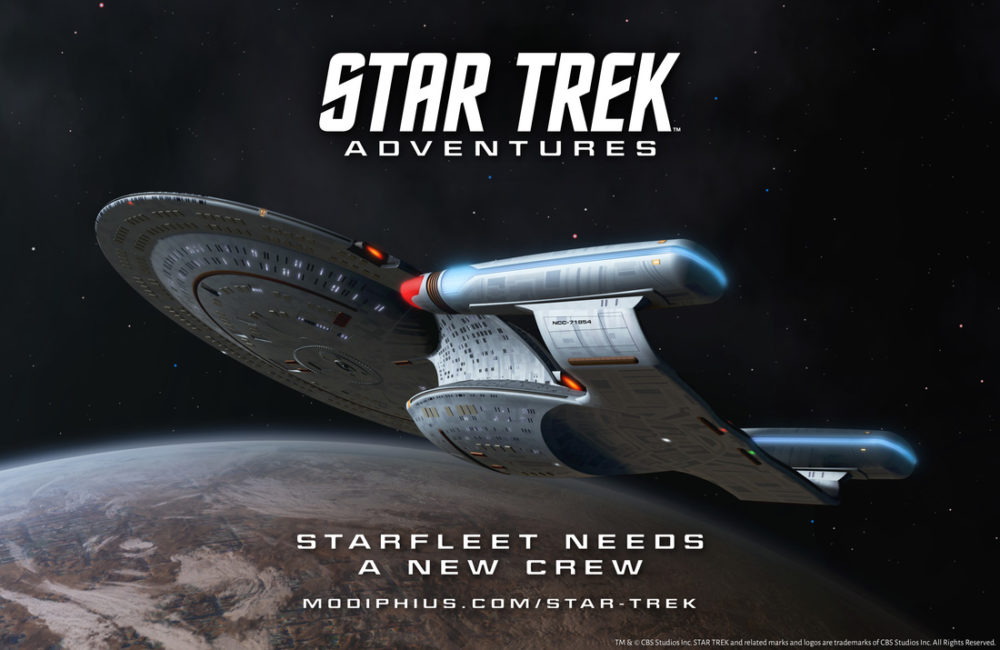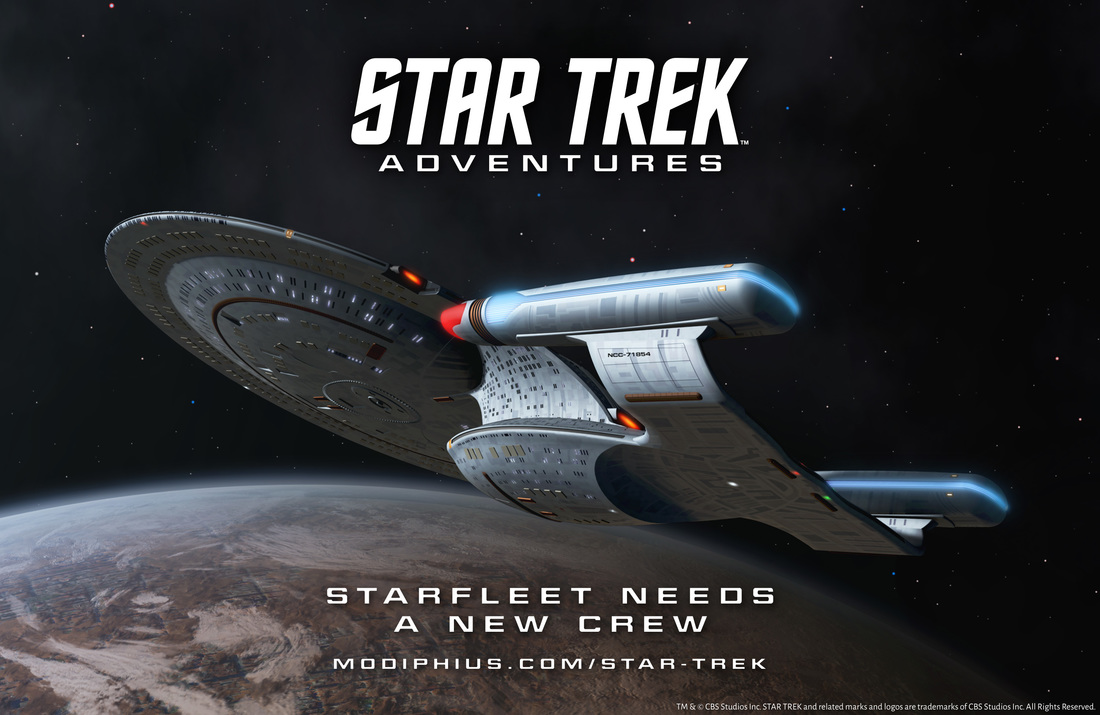 In anticipation of the Star Trek Adventures RPG from Modiphius, I downloaded and read both the Infinity and Conan Quickstart PDFs from Modiphius to get a sense of how the 2d20 mechanics work. I’ll post more after I actually get to run and play in 2d20 games, but I’ve got some thoughts after a read-through that I wanted to post (mostly based on the Conan RPG version).
In anticipation of the Star Trek Adventures RPG from Modiphius, I downloaded and read both the Infinity and Conan Quickstart PDFs from Modiphius to get a sense of how the 2d20 mechanics work. I’ll post more after I actually get to run and play in 2d20 games, but I’ve got some thoughts after a read-through that I wanted to post (mostly based on the Conan RPG version).
First off, I’m IMMENSELY excited about the 2d20 mechanics of the upcoming Star Trek Adventures RPG. The closest game I can compare it to is Star Wars: Edge of the Empire, which is not surprising since game design Jay Little designed them both.
One caveat: all the 2d20 mechanics below are subject to change based on how Modiphius implements 2d20 for Star Trek.
Here’s a quick summary of the system from Modiphius:
The 2d20 system is a dynamic, narrative system, designed to produce varied and interesting results from dramatic and action-packed situations. Characters roll two d20s, attempting to roll as low as possible on each one – the more dice that roll low, the more successes the character scores.
Tasks will require one or more successes to be successful, and any successes scored beyond that minimum become Momentum, which can be spent to achieve a variety of advantageous effects. However, this can come at a cost: characters who wish to succeed can push their luck, rolling extra d20s to boost their chances of success and the Momentum they generate. However, each extra d20 comes from the character’s resources – such as stocks of arrows – or adds to a pool of Doom that represents all the things that can go wrong in an adventure, which the GM can spend to complicate adventures and scenarios and make the characters’ lives interesting.
The game has a nice ‘best of’ approach that incorporates mechanics seen in traditional games like D&D & Traveller, while also pulling in nice modern innovations from story games like Fate and Cortex Plus. I’ll list out some key mechanics and point out the game systems were I’ve previously seen the game mechanics.
Attributes & Skills. 2d20 has 7 attributes (similar to D&D and Traveller which have 6-7). To this you add your Skill Expertise, which sets your target number for success. Very familiar and proven.
Armor and Courage can soak damage. I like that extra ‘soaking’ step which I first say in Chaosium’s Stormbringer RPG from the 80s.
There are two Stress tracks (Vigor and Resolve) which spill over to 2 Harm tracks which roughly feel like Fate’s Physical and Mental stress/consequences mechanic.
Talents equate to Stunts or Feats and I expect will feel like Edge of the Empire’s Talent Trees.
There are three spendable point systems.
Fortune Points feel like a nice mashup of Savage Worlds bennies (awarded for cool or entertaining roleplaying) and Fate Points (spending for things which include minor narrative declarations).
Momentum and Doom are player and GM facing token pools which have an economy — players and the GM make choices which effect both pools. Feels a lot like the Star Wars: Edge of the Empire Force Points with points flowing from player to the GM.
In general I find token-based games cool in that I can use themed tokens to accessorize the game and increase the flavor of the genre at the table.
Turn order is akin to Cortex Plus in what some people call Popcorn Initiative. Players always go first but choose among themselves who goes in what order. GM characters go last unless they spend Doom points to interrupt and go earlier. I like that style; works great to encourage team-ups and group strategy while reducing time to deal cards or roll dice to determine turn order.
Battlemats are semi-abstracted and use Fate’s notion of Zones with a bit of 13th Age Engaged/Near/Far mechanics to quickly determine ranges and movement without counting squares. Will be curious to see if Star Trek Adventures keeps this approach given they have promised terrain tiles in their product line.
Important to me is that the 2d20 system uses d20 and d6 dice only, and doesn’t rely on color (I’m color blind; this was a show-stopper for me running Edge of the Empire which I otherwise found to be a fantastic system).
Rolling low is better, and a 20 on a d20 means something bad happens. I love this mechanic from Edge of the Empire as it really drives story in a way few other games can.
Lastly, the core thing which marks this system (for good or ill) is that it, like Star Wars: Edge of the Empire or Firefly: Cortex Plus, Star Trek Adventures promises to be a Story Game system which has back-end crunch to keep players engaged as they level up and play over the long run. Unlike story games like Fate which feel lacking after a dozen or so games to those players who feel the need to constantly level and get mechanical improvement, 2d20 promises to have enough fiddly bits to keep power and tactical games engaged for the long haul.
The downside is that it’s not a straightforward and simple as a game like Fate. I predict Star Trek Adventures will be overly crunchy for one-shots or short mini-campaigns. What it will be a good fit for are long term games which have the story game core game flow while keeping the ‘game’ part of the campaign constantly interesting and growing.
I therefore expect Star Trek Adventures will be great for multi-year play, but overkill for one-shots.
In conclusion, I’m excited! Looking forward to the beta test and organized play.




I am also excited about me two wound tracks. I like the idea of knocking opponents out of the fight with a glare. Reminds me of a samurai showdown.
Most of the people I see reviewing the system do not like it. About 1/3 do, and tend to be positively gushing, while the other 2/3 detest it.
I’ve serious dislike for what I’ve seen. Which includes the quickstart for conan.
Popcorn initiative in Cortex Plus isn’t “All the PC’s then all the bad guys” – but tends to flow around, so 2d20’s version isn’t really that similar, it’s more akin to BECMI D&D… side vs side… except that the PC’s always have the initiative.
3 spendables, 2 of which are mechanically parallel, but aren’t actually linked in the game… three things to track, and thus three piles of stuff to track with bits, or three public numbers to write on the whiteboard.
Multiple wound tracks is also a potential problem, in that it again doesn’t mirror what we see in trek all that well, where a klingon is less resistant to stun once injured. It’s not as profound an effect as staking in buffy requiring the Vamp to be bloodily beaten senseless. It was actually one of the more complained about elements of Prime Directive (1E)… it’s added complexity, added tracking.
Zones are not well explained in the Conan QS, if I hadn’t used them in AMSH and Fate, i’d not have grasped them from the QS.
I’ve run some numbers, and don’t at all care for where they are pointing, mechanically, for the task sysem.
Modiphus has constantly tried to divert system discussions of the system (on multiple boards, both for Conan and Mutant Chronicles) to how pretty the book is going to be; this also shows a misplaced emphasis. Which makes me wonder if they actually are doing all that much adapting…
So, I’m not excited; I’m bummed.